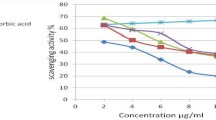Abstract
Synthesis of lipophilic catechin derivatives was carried out to improve their solubility in lipidic substances that must be protected against oxidation. For this purpose, an oxa-Pictet-Spengler coupling reaction, which is not only conservative for antioxidative activity, but also simple, mild and inexpensive, was applied. This method permitted grafting of alkyl chains, from various methyl ketones, between the C and B rings of catechin. The derivatives were isolated, on the one hand, by silica gel column chromatography and, on the other, by simple aqueous washing of the crude product. Both treatments produced almost the same purity; products of the second one had best antioxidative activities given by inhibition of the induced oxidation of methyl linoleate and by reactivity with the free radical 2,2-diphenyl-picrylhydrazyl. All derivatives acquired a lipophilic character as proven by measurement of the partition coefficient between octanol and water.




Similar content being viewed by others
References
Johnson DR, Gu LC (1988) Autoxidation and antioxidants. Wiley, New York, pp 433–448
Zhang CX, Wu H, Weng XC (2004) Two novel synthetic antioxidants for deep-frying oils. Food Chem 84:219–222
Sroka Z (2005) Antioxidative and antiradical properties of plant phenolics. Zeitschrift für Naturforschung, C. J Biosci 60:833–843
Sun T, Powers JR (2007) Antioxidants and antioxidant activities of vegetables. ACS Symposium Series 956 (Antioxidant Measurement and Applications), pp 160–183
Takizawa Y, Nakahashi K, Baba K (1992) Antioxidative effect and oxidation of quercetin derivatives in lipids. Int Congr Ser 74:9–752
Lewis PT, Wähälä K, Hoikkala A, Mutikainen I, Meng Q, Adlercreutz H, Tikkanen MJ (2000) Synthesis of antioxidant isoflavone fatty acid esters. Tetrahedron 56:7805–7810
Park KD, Park YS, Cho SJ, Sun WS, Kim SH, Jung DH, Kim JH (2004) Antimicrobial activity of 3-O-acyl-(−)-epicatechin and 3-O-acyl-(+)-catechin derivatives. Planta Medica 70:272–276
Chen P, Du Q (2003) Isolation and purification of a novel long-chain acyl catechin from lipophilic tea polyphenols. Chin J Chem 21:979–981
Jin G, Yoshioka H (2005) Synthesis of lipophilic poly-lauroy-(+)-catechins and radical-scavenging activity. Biosci Biotechnol Biochem 69:440–447
Fukuhara K, Nakanishi I, Kansui H, Sugiyama E, Kimura M, Shimada T, Urano S, Yamaguchi K, Miyata N (2002) Enhanced radical-scavenging activity of a planar catechin analogue. J Am Chem Soc 124:5952–5953
Hakamata W, Nakanishi I, Masuda Y, Shimizu T, Higuchi H, Nakamura Y, Saito S, Urano S, Oku T, Ozawa T, Ikota N, Miyata N, Okuda H, Fukuhara KJ (2006) Planar catechin analogues with alkyl side chains: a potent antioxidant and an α-glucosidase inhibitor. J Am Chem Soc 128:6524–6525
Peng Z, Hayasaka Y, Iland PG, Sefton M, Høj P, Waters EJ (2001) Quantitative analysis of polymeric procyanidins (tannins) from grape (Vitis vinifera) seeds by reverse phase high-performance liquid chromatography. J Agric Food Chem 49:26–31
Eloualja H, Perrin D, Martin R (1995) Influence of β-carotene on the induced oxidation of ethyl linoleate. New J Chem 19:1187–1198
Takàcs-Novàk K, Avdeef A (1996) Interlaboratory study of log P determination by shake-flask and potentiometric methods. J Pharm Biomed Anal 14:1405–1413
Diouf P-N, Merlin A, Perrin D (2006) Antioxidant properties of wood extracts and colour stability of woods. Ann For Sci 63:525–534
Shoji A, Yanagida A, Shindo H, Shibusawa Y (2004) Comparison of elution of catechins in high-performance liquid chromatography with that on high-speed counter-current chromatography. Bunseki Kagaku 53:953–958
Yang B, Kotani A, Arai K, Kusu F (2001) Relationship of electrochemical oxidation of catechins on their antioxidant activity in microsomial lipid peroxidation. Chem Pharm Bull 49:747–751
Litwinienko G, Ingold KU (2004) Abnormal solvent effects on hydrogen atom abstraction. 2. Resolution of the curcumin antioxidant controversy. The role of sequential proton loss electron transfer. J Org Chem 69:5888–5896
Foti MC, Daquino C, Geraci C (2004) Electron-transfer reaction of cinnamic acids and their methyl esters with the DPPH radical in alcoholic solutions. J Org Chem 69:2309–2314
Author information
Authors and Affiliations
Corresponding author
Rights and permissions
About this article
Cite this article
Poaty, B., Dumarçay, S. & Perrin, D. New lipophilic catechin derivatives by oxa-Pictet-Spengler reaction. Eur Food Res Technol 230, 111–117 (2009). https://doi.org/10.1007/s00217-009-1149-2
Received:
Revised:
Accepted:
Published:
Issue Date:
DOI: https://doi.org/10.1007/s00217-009-1149-2



